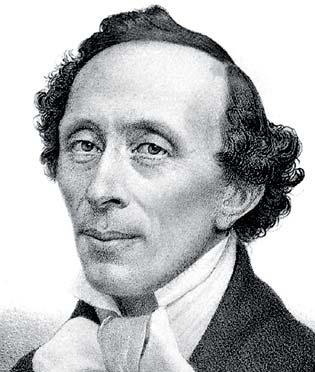Biography of Hans Christian Andersen
Hans Christian Andersen, (April 2, 1805 – August 4, 1875) was a Danish author and poet famous for his fairy tales.
Upbringing
 Hans Christian Andersen was born in Odense, Denmark, on the April 2, 1805. He was the son of a sickly young shoemaker of twenty-two and his several years older wife. The whole family lived and slept in one little room.
Hans Christian Andersen was born in Odense, Denmark, on the April 2, 1805. He was the son of a sickly young shoemaker of twenty-two and his several years older wife. The whole family lived and slept in one little room.
Hans Christian showed imagination early, which was fostered by the indulgence of his parents and by his mother’s superstition. In 1816, the shoemaker died and the child was left entirely to his own devices. Hans Christian ceased to go to school. He built himself a little toy-theatre and sat at home making clothes for his puppets, and reading all the plays that he could borrow; among them were those of Ludvig Holberg and William Shakespeare. Andersen, throughout his childhood, had a passionate love for literature. He was known to memorize entire Shakespeare plays and recite them using his wooden dolls as the characters.
King Frederick VI was interested in the strange boy and sent him for some years, free of charge, to the grammar-school at Slagelse. Before he started for school, Andersen published his first volume, The Ghost at Palnatoke’s Grave (1822). Andersen, a very backward and unwilling pupil, actually remained at Slagelse and at another school in Elsinore until 1827. These years, he says, were the darkest and bitterest in his life. Collin at length consented to consider him educated, and Andersen came to Copenhagen.
Life as an author
In 1829, Andersen had considerable success with a fantastic volume entitled A Journey on Foot from Holmen’s Canal to the East Point of Amager, and he published in the same season a farce and a book of poems. Thus, he suddenly came into request at the moment when his friends had decided that no good thing would ever come out of his early eccentricity and vivacity.
He made little further progress, however, until 1833, when he received a small traveling stipend from the king, and made the first of his long European journeys. At Le Locle, in the Jura, he wrote Agnete and the Merman; and in October 1834 he arrived in Rome.
Early in 1835, Andersen’s first novel, The Improvisatore, appeared, and achieved real success. The poet’s troubles were at an end at last. In the same year, Andersen published the earliest installment of his immortal Fairy Tales (Danish: Eventyr). Other parts, completing the first volume, appeared in 1836 and 1837. The value of these stories was not at first perceived, and they sold slowly. Andersen was more successful for the time being with a novel, O.T. (1836), and a volume of sketches, In Sweden. In 1837, he produced the best of his novels, Only a Fiddler.
Andersen now turned his attention, with but ephemeral success, to the theatre, but was recalled to his true genius in the charming miscellany of 1840, the Picture-Book without Pictures the fame of his Fairy Tales had been steadily rising; a second series began in 1838; a third in 1845.
Andersen was now celebrated throughout Europe, although in Denmark itself there was still some resistance to his pretensions. In June 1847, he paid his first visit to England and enjoyed a triumphal social success. When he left, Charles Dickens saw him off from Ramsgate pier (Shortly thereafter Dickens published David Copperfield, in which the character Uriah Heep is said to have been modeled on Andersen—a left-handed compliment, to say the least).
After this, Andersen continued to publish much as he still desired to excel as a novelist and a dramatist, which he could not do. He disdained the enchanting Fairy Tales, in the composition of which his unique genius lay. Nevertheless, he continued to write them, and in 1847 and 1848 two fresh volumes appeared. After a long silence, Andersen published another novel in 1857, To be or not to be. In 1863, after a very interesting journey, he issued another of his travel-books, In Spain.
His Fairy Tales continued to appear, in installments, until 1872, when, at Christmas, the last stories were published. In the spring of that year, Andersen fell out of bed and severely hurt himself. He was never again quite well, but he lived until the 4th of August 1875, when he died very peacefully in the house called Rolighed, near Copenhagen. He is interred in the Assistens Cemetery, in Copenhagen, Denmark.
In the English-speaking world, the stories of The Ugly Duckling, The Emperor’s New Clothes, and The Princess and the Pea, are cultural universals; everyone knows them, though few could tell you their author. They have become part of the common heritage, and, like the tales of Charles Perrault, are not distinguished from actual folk-tales such as those of the Brothers Grimm.